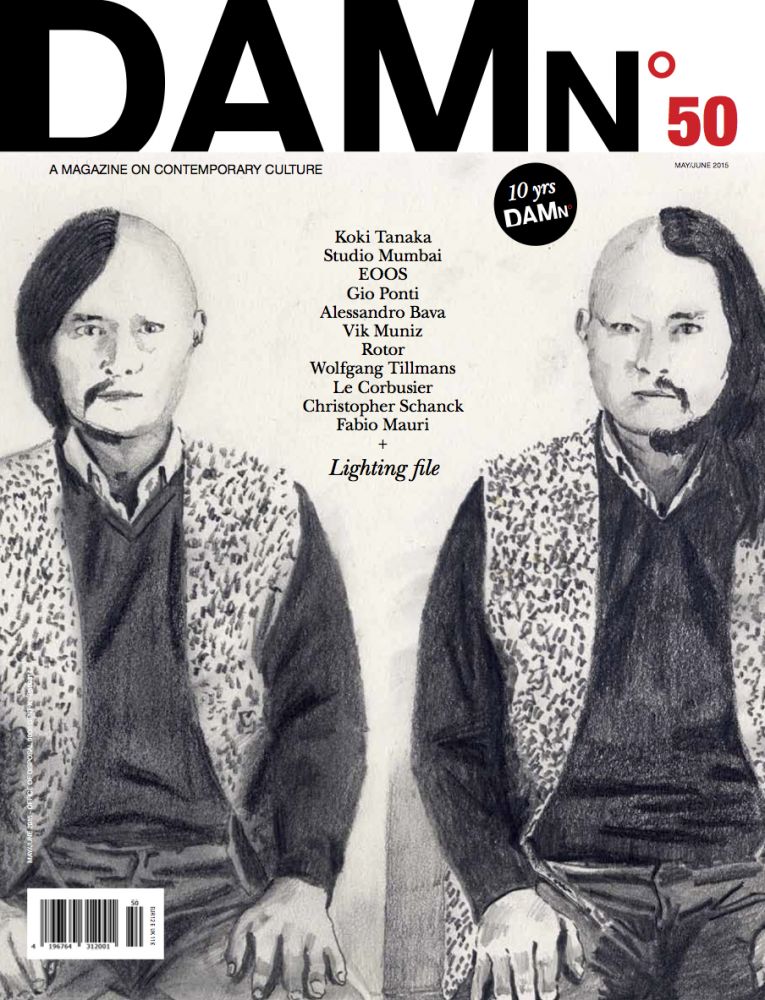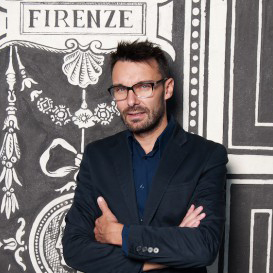EOOS, the design studio founded by Martin Bergmann, Gernot Bohmann, and Harald Gründl and named after one of the mythical horses pulling the sun chariot in Ovid’s Metamorphoses, is turning 20. The name signifies its endeavours, or as they put it: “Everything takes place somewhere between being burned and getting lost.” Unlike the valiant sojourn of sun god Helios’s son, their enterprise has not ended in catastrophe, but has rather led to a stately portfolio and an impressive list of international clients and awards. Hence, this is a good moment for an overview.

From the very beginning, EOOS concentrated mainly on international clients. The important furniture fairs in Milan and Cologne became central contact points for paving the way to commissions. The studio cleared this hurdle together with German table manufacturer Läsko, for which they created Horse Table and Two in One. These two dining tables carry EOOS’s DNA: the principle of transformation and the multiple use of an object that calls for interaction with the user. In the same year (1996), the design of a multifunctional presentation space for advertising agency Euro RSCG offered the trio their first big opportunity to show-off their talent for interiors. A quest for mythology in imagery, rituals, or stories becomes a collective method, informing Bergmann, Bohmann, and Gründl’s design approach to this day. They call it Poetical Analysis, and even trademarked the expression. It helps them avoid being burned or getting lost. They use this to generate their very own system of images, words, and thoughts, and to process these through a common language whose vocabulary draws from the archaic and high-tech. They work intentionally with so-called double images, which represent the two contrasting poles whose fusion yields something new. Poetry and analysis describe the only seemingly contrary, intuitive, and rational ways of thinking that accompany EOOS in their search for solutions.

 This article appeared in DAMN°50. Order your personal copy.
This article appeared in DAMN°50. Order your personal copy.
Long-term satisfaction
Besides a reduction to the essential, the translation of brand identity into a product is intrinsic in an EOOS design. “100% client, 100% EOOS” is a maxim of the trio, who are without any stylistic airs and graces. George Lounge for Walter Knoll pays homage to one of their heroes, George Nelson, whose own designs and consultations with the likes of Charles and Ray Eames or Isamu Noguchi, culminated in American manufacturer Herman Miller’s characteristic furniture line. With the lounge chair and ottoman, EOOS refer to the Prodomo system from the 1920s, which works with the novel steel tube of that era. An even more radical piece is Atelier Chair, a seat that quotes many steel tube classics, plays with volumes and lines, and demands an upright sitting position – a chair for thinking, not lingering.
Their straight lines also convinced another German furniture maker. “Away with design!” is the concise briefing given to them by Gerd Bulthaup for a counterpart to the existing freestanding kitchen workbench. The modular kitchen system b2, consisting of a workbench, cabinet, and appliance housing, draws from the simplicity of mediaeval kitchen interiors and impresses with its radical functionality. EOOS achieved a distinctive solution that also fits into the Bulthaup tradition as characterised by Ulm School of Design co-founder, Otl Aicher. EOOS even provided an update to Aicher’s 1982 book Die Küche zum Kochen, publishing its own experiences and methods in The Cooked Kitchen. A Poetical Analysis.
The award-winning, longstanding collaboration with Walter Knoll is complemented by a subsequent, equally intensive affiliation with Canadian manufacturer Keilhauer, putting the trio on the North American map. Sguig, an ergonomic task chair, resulted from an elaborate research project aiming to combine the exercise ball’s dynamic sitting position with the comfort of an office swivel chair, for which a computer program was specially developed. EOOS employs technological know-how to make complex mechanical processes as invisible as possible.
Spatial reform
The aforementioned exhibition at Galleria Carla Sozzani led to a commission for the development of a worldwide shop concept for Giorgio Armani Cosmetics. A system of modular furniture that achieves calm surfaces in a room in which customers are screened-off behind mirrors, set new design standards in the cosmetics sector in 2000. Fashion designer Michael Michalsky, then global creative director at Adidas, took notice. For the introduction of the Adidas retro collection, Originals, he invited EOOS to make a pitch. A radical yet poetic proposal prevailed, and the studio was commissioned to realise flagship stores in Berlin, New York, and Tokyo, with a concept inspired by urban trade scenarios such as flea markets and street merchants. Reminiscent of blankets on the ground, low table islands serve as presentation surfaces for the products, and offer places where customers can sit down and try-on sneakers. Clothing racks are removed from the walls and transferred to the middle of the room, to evoke a more temporal atmosphere. The sales room is also the storage room. Even the cash till can transform into a DJ booth and, in turn, the shop into a club. The youth of digital modernity also follow the ancient instinct of hunters and collectors.Besides commercial spaces, the realm of art has been important to EOOS from the outset – not for them to be perceived as artists, but as “a free space for experiment and applied research that could perhaps manifest in concrete projects as well.” Works like the Content Dispenser for artist group Instinct Domain, or the installation HockerSesselTischRaum, which deals with shifting scales, are exemplary of this approach. Later, Tyrolean furniture workshop Hussl commissioned EOOS to explore reinterpretations of archaic Alpine furniture typologies, resulting in a simple, poetic furniture series.
EOOS does not develop special concepts on the basis of an architectural floor plan, but rather on the function of a room and the furnishings that optimise it, transform it, or facilitate surprising functions. Sitting landscapes, such as Living Landscape or Threesixty for Walter Knoll, which EOOS sees as ‘room gear’, propose different experiences of space through their transformational capacities – for example, by rotating one or more elements. Depending on the position, the view falls to the open fire (or plasma screen), to one’s conversation partner, or to the outside. A similar example is the Sundeck bathtub, which can wander out onto the terrace or into the living room, regardless of the weather. The wood cladding and cushioned covering, which turn the tub into a lounger, integrate this taboo item into the social sphere. A 360-degree panorama and a living culture freed from walls are central visions in many of EOOS’s creations, ensuring the mobility of the inhabitants in space through furniture.
New horizons
After years of building up the studio – at times with more than 20 staff – and intensive shop design projects that sent EOOS on relentless travels round the world, the moment came for the founders to evaluate and reorient. They subjected their own field of work to Poetical Analysis, and published the book The Death of Fashion: The Passage Rite of Fashion in the Show Window. “Just as in ancient Greece, the god of fertility had to be killed during the Dionysia in order to be resurrected, the season’s fashion of today has to be symbolically sacrificed in order for shop windows to be filled with something new”, as stated on the dust jacket. That text would mark a turning point. EOOS thus defied the ritual of the eternally new, and decided to no longer make any short-lived shops. The team was considerably reduced, and projects were carefully selected. Product and furniture design were intensified, while matters of ecological and social responsibility were added in. Collaborations with longstanding clients were thereby broadened, since the shared goal from the start was to create sustainable objects. Now extensive research is also conducted on product lifecycles. These ambitions manifest in the Liviano spotlight manufactured by Zumtobel, where the number of parts and the housing material were cut by half, representing a considerable improvement in the CO2 footprint.
Among the main challenges of the 21st century is the mandatory change to a low-carbon society. Freedom from the dependency on fossil fuels and emission-free energy production are important steps in the search for alternatives. This includes renewable biological resources with a high growth rate, such as algae, which absorbs CO2 in the growth process and thereby represents a CO2-neutral source of energy production. Since 2010, EOOS has been conducting research together with national and international facilities on the use of algae power stations in private homes and communities. Plant 2 is a vision for a self-sufficient house, its form the result of its function as a power station. The water-well as the central supply point in mediaeval villages serves as a metaphor for the urban bioreactor Plant 3 (Algae Community Power Station). With this concept, the studio became a finalist for the new Victor J. Papanek Social Design Award, initiated by MAD (Museum of Art and Design) in New York and the University of Applied Arts in Vienna. Plant 1, an idea for a filling station using biofuel from algae oil, introduced the engagement with green power.
To the loo
The Blue Diversion Toilet, developed by EOOS in collaboration with Swiss water research institute Eawag in the framework of the Reinvent the Toilet Challenge by the Bill & Melinda Gates Foundation, is a simple, environmentally-friendly toilet for developing and threshold countries. It functions without a connection to the sewer, without electricity, and only needs a single filling of water, which a recovery system continuously turns into clean water for flushing and hand washing. According to WHO, more than one-third of the world population does not have access to hygienic, safe sanitary systems. Sickness and death are daily occurrences in these living conditions.This toilet – developed as a mass item for use in slums and made of recyclable blue plastic that can be produced almost anywhere – is likely the team’s most successful project to date, alongside the luxury b2 kitchen. It illustrates that EOOS has accessed new contexts in a terrain between social extremes. Both products underwent an intensive design process and demonstrate that thinking in two separate worlds is not necessary; rather, they are mutually inspiring and profit from the experience gained in past projects. EOOS has realised products from ballpoint pens and lighting systems to office and home furnishings. Moreover, the team never ceases to think up new visions and to apply the principle of transformation. With Poetical Analysis as the basis for designing, the studio has developed a unique tool that has become a sort of trademark, almost a signature. Even in the age of digital modernity, EOOS pursues the reactivation and transformation of ancient rituals.






